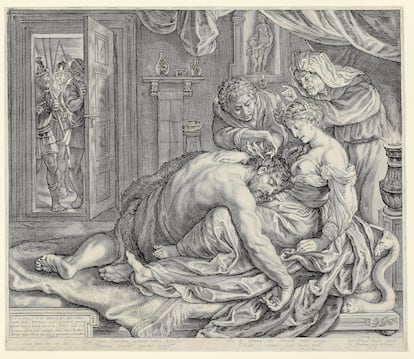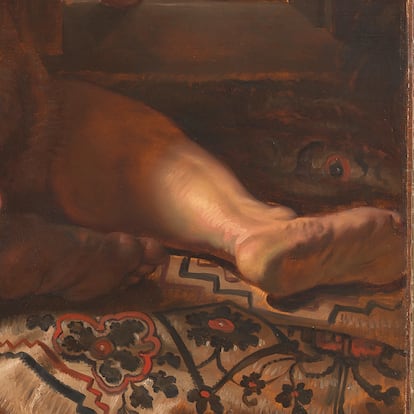Upon entering room 15 of the National Gallery of London, the visitor is heading hypnotized towards the bottom box. Samson, a giant kneading of muscles with the bare torso, rests exhausted on Dalila’s lap, which shows her bare breasts. An accomplice of the beautiful Philistine with scissors with the hair of the Israelite colossus, to remove his strength. Samson and Dalila It is one of the thirty masterpieces of its permanent collection that proudly highlights the British National Pinacoteca, attributed to the Master of the Flamenco Baroque Pedro Pablo Rubens. The controversy about the authorship of the work, which lasts almost forty years, is one of the most intense and violent in the art world.
“It was the first time that I saw him, in the blink of an eye. It was 1987, in the National Gallery. Doxyadis, who has dedicated half a life to denying the authorship of the painting and leads an international critics group. All his research decades have been spotted in a book, NG6461: The Fake Rubens (NG6461: False Rubens, referring to the catalog number in the National Gallery). Published last March, the battle between the artist and the London Museum has resurrected.
To understand this story well, it is necessary to rebuild the facts, observe the brushstrokes of the painting closely and magnifying up, travel in time, and, above all, to attend with the necessary dose of skepticism both the certainties and the theories that defend one and another.
Rubens painted Samson and Dalila At the beginning of his mature time, at the beginning of the seventeenth. He had just returned from a long journey through Italy, where he learned from the masters of the Renaissance as Miguel Ángel or Leonardo, but above all he was seduced by a transgressive, revolutionary, fierce artist in the light and in the stroke, called Caravaggio.
It is very possible that the work was a commission of his friend and mentor, the mayor of Antwerp, Nicolaas Rockox, whose house is today a museum. No one doubts that the painting existed. But when Rockox died in 1640, as has happened with many other famous paintings, it disappeared.
For more than two centuries, the only two evidence of the existence of the work were indirect. First, the box entitled Dinner at the Burgomaster Rockox Houseby painter Frans II Franken. It belongs to this genre baptized as “painting of rooms of wonders”, very claimed by the private collectors who wanted to show, in an image that served as an inventory, all its accumulated wealth. In this case, the key is that in the center of the room, among other reproductions, you can see the Samson and Dalila The Rubens.
The second test is an engraving of the picture made by the Dutch printer Jacob Matham, in 1613, most likely commissioning Mayor Rockox himself.

The reappearance and the first doubts
Samson and Dalila It did not reappear until 1929, in Paris. It was then that an expert in Rubens, the German Ludwig Burchard, gave faith of authorship. It was a historical finding in the art world. The problem, however, is that when the aforementioned expert died, in 1960, it was discovered that he had given a great handful of fake ‘rubens’ to enrich himself.
In 1980, the National Gallery used its funds to acquire the work, at an auction of the Christie’s house. He paid 2.5 million pounds sterling (almost 3 million euros to the current change). A thorough, with the prices that are handled today, but a record at that time, which monopolized holders.
Since then, the museum has not fought from a curse around the painting that has never been able to settle completely.

Let’s start with the revealing details that, according to the complainants, give away the falsehood of the work. The first, perhaps the most striking and the one that can serve to convince a profane of art more easily: Samson’s foot. In the picture set forth in the National Gallery, the frame cuts the fingers of the right foot of the giant. As in those photos of fans in which the frame is incorrect, and one hand or the feet are cut.
But both in Matham’s engraving and Franken’s canvas, the foot appears whole. Hands and feet are extremely difficult to draw or paint. Rubens dominated those details, to the point of dedicating a work to the matter called Study of the feet. It is strange that, with that ability, he will choose to make his fingers disappear, thus breaking the balance of the composition.
And there are more clues. In the upper left corner of the painting appears a statue of Venus and Cupid. Brush looks like rough, little defined, in a gray tone.

“Rubens came to write in Latin a book in which he developed a whole theory on how to paint statues, Imitation of statues“Explains the Greek historian.” And always used ocher and earth tones, never black and white. “
At the bottom of the box, on the right, as in Las Meninas From Velázquez, there is a door. Five people contemplate the scene. One of them looks directly at the viewer, as if looking for its complicity. In Matham’s engraving or in the Franken painting there are only three witnesses. This discrepancy would be one more proof of Doxyadis’s surprising theory about the authorship of the work, which for her is a copy.
According to the Greek author, the painting emerged from the group of disciples grouped in Madrid, at the beginning of the 20th century, around the painter Joaquín Sorolla. The copy of the classics was a good way of exercising, and Rubens, for his mastery, was a favorite among students. The author of the copy would have been Gaston Lévy, a collector and conservative who ended his days in New York, but who learned from the hand of the Valencian postimpressionist painter.
To demonstrate the good faith of a copy, and make it clear that it is not intended to make a malicious imitation, it is unwritten norm in the art world to capture some subtle difference with the original work that of the plagiarism: for example, a cut foot or an accomplice face that looks at the viewer.

“We discovered the name of Lévy among Burchard’s notes -the German expert who confirmed in 1929 the authenticity of the work -, in 2000, among the documents of the National Gallery.
To finish the controversy, the historian ensures that the piece exhibited in the National Gallery is not an oil on oak wood, such as the historical original, but a canvas attached to a plank that was subsequently reinforced from behind with another wooden plate. He insists that those responsible for the museum refuse to deny, with the help of technology, their statement.
The battle of the National Gallery
The museum has dedicated years of work of its experts to confirm the authorship of their star picture and silence what for them are conspiracy without foundation. In recent dates he has published an exhaustive report signed by three academics, led by Gregory Martin, one of the world’s largest experts in Rubens. “This extensive study, led by our team of conservatives and scientists, who uses the most modern techniques in image and analysis, offers very conclusive evidence of authorship, as well as the transparency of our research tasks,” the director of the museum, Gabriele Finaldi, wrote a little over a week ago, Gabriele Finaldi, to the newspaper The Guardianwhich had also echoed the controversy. The National Gallery has not wanted to talk to the country, but has sent to this correspondent the technical report of its experts.
There are many specialists and critics who have put themselves on the side of the British pinacoteca and defend the authorship of Rubens. In the art world, when the evidence is not entirely conclusive, intuition, knowledge and imagination work. And this is where a painter mentioned at the beginning of this story reappears: Caravaggio. Perhaps he is the last key to understanding a painting that, for his strokes, his tenebrism and his execution does not seem like Rubens.
“Even when he mimics to Caravaggio, Rubens cannot avoid being himself. Light (the painting) is his. The brightness of the candle is creamy and warm, like a crepe in a cuisine of Antwerp. The mixture of southern sensuality and warmth of northern home is another feature of Rubens. The extravagance of a work that takes out so many caravaggioismo and with carnal abandonment of Rubens- it is in fact a clue about its authenticity. Who could have recreated in a copy something as subtle as the time when Rubens appropriates Caravaggio? ”Has written art critic Jonathan Jones in The Guardian.
The truth, like beauty, belongs to the viewer’s gaze. And the work Samson and Dalilalike many others, she is eternally condemned to be an act of faith for her fans and an insult to her detractors.

